The Green 30s and 40s
Granolas in Zoot Suits!

Even the Romans Were Concerned About the Environment
The sign essentially says "Don't Litter"
Click on the Photo to Enlarge It
This is a look at today's environmental concerns through the lens of history. It turns out that most of the "new" ideas were around in the 1930s and 1940s (and before). There is no doubt that our environment could use a good cleaning, however, I'm just a bit suspicious of the way that this is being done today. We have a VAST environmental industry that is more-or-less self-perpetuating. I'd really like to figure out what "clean enough" means, do that, and send all the enviros back to work at productive jobs. I am particularly annoyed at the Environmental Law industry in which attorneys enrich themselves by minutely examining the meaning of complex regulations. If I had a choice between Lawyers and Smog, I'd take the latter in a heartbeat.
I'm also going to poke fun at a whole generation of that was raised by fanatically antiseptic moms, who ran around spraying everything with sanitizer. These kids never walked anywhere (other than to and from the minivan) and had most of their early experiences in cyberspace. It is no wonder that these people feel that the world is a dangerous, dirty place. I grew up in Pittsburgh at its worst. I believe that the world is pretty clean. The other thing that I cannot fathom about the current wave of college kids is that they scream about cleanliness and sanitation but they take vacations in Pingpongistan or some other godawful place at the end of the world with no toilets and hostile unwashed natives with bones in their noses. (Come to think of it, for those of you with a limited budget, that could be Berkeley or Madison just as well...)
Possibly, you are one of those sweet young things with big round eyes, filled with the milk of human kindness who think that Professor Klaus Blowhardski (the Aryan god with convenient office hours) actually invented one (or all) of these technologies. Yes, I am sooo negative -- isn't annoying how much factual material is presented here along with the dark humor?
Myself, I like neon, nightclubs, and reliable utilities. So, now that we know our differences, let's go on. Before you write a nasty note, pause to ask yourself honestly: Do I know any Enviro-Hypocrites? If not, then write the note. Otherwise take all of this with a grain of salt and enjoy yourself.
We have adopted a "holistic" approach that will offend everyone, save possibly those who dined on Whale last evening.

Hunting Whales With Bombs
Click Here to download the full story on "Hunting Whales With Bombs"
From the June, 1932 issue of Popular Mechanics
Click to Enlarge
However, if you are hyper-sensitive to a particular environmental topic, you may go directly there:
- General Overview
- Case In Point: The University of Washington
- Synthetics
- Alternative Fuels (not Ethanol)
- Ethanol
- Logging the Rain Forest
- Solar Power
- Wave Power
- Air Quality
- Methane from Biomass
- Global Warming
- Hydrocarbons
- Wind Power
- Compact Fluorescent Lamps
- Distributed Generation
- LEED Certification
- Nuclear Energy
- Space Exploration
- Highway Planning
- Turn Me In to the nearest Enviro-commissar
- Case In Point: The University of Washington
Otherwise, just scroll down and let your righteous anger build. Let's get off to a good start: 80% of the animals on the Endangered Species list are Reptiles, Rodents and Insects.
The zillions of dollars that are spent on "Cleaning Up the Environment" have spawned an Industry that operates in Seven Phases:
- FEAR: "Scientists" (read college professors who want a Maserati) create theories that public health is in danger. Such theories are best if they can be encapsulated in good sound bites. The best theories argue for something dire that is going to happen 30 years from now unless we toss money at it right away; better yet -- something that might affect children
- CONCERN: Easily led college students are filled with grand dreams of large salaries as the Commissar of Pollution Control with all the attendant pomp and circumstance; if possible, elementary school children are indoctrinated (remember Woodsy Owl then -- or Inhabitots today?)
- BALLYHOO: 24 hour a day cable networks trumpet the fear and twist any and all current events to fit whatever fear-fad is afoot
- LEGISLATION: Congress caves in to the ballyhoo and passes laws aimed at reducing fear
- BUREAUCRATIZATION: A vast agency is created to perform the day-to-day regulation, employing the legions of zealots spawned in the academic community; certification is offered to transform garbagemen into Sanitary Engineers or Licensed Mold Inspectors or Radon Investigators or LEED Certification Professionals. (As the Great Oz said: "Why do you need a Brain when you have a Certificate?")
- LITIGATION: The regulations are always subject to question, so an army of lawyers representing both sides begins to feast
- STEADY STATE: Fear and regulatory burden come to balance; all available plum jobs are taken and a new generation of "scientists" finds a new fear (back to #1...)
So, while the 6 million people who work in the Environment Industry trade "pollution credits" with each other, all the manufacturing jobs in the US have been shipped to China where they pollute like hell. Take a look at this official NASA photo of China: The whole country looks like Los Angeles in the 1960s!

Chinese Air Quality
If the Chinese had a few envirocrats, maybe some of the jobs would come back to the US... Well, the dictators shut down industry to clear the air for the Olympics. Maybe they should have the Olympics on a permanent basis. We could send them some of our little environmentalists and big fat greedy lawyers to help out. Of course, we can't really do anything about China because the sensitive tweets that have burrowed into the maw of the State Department would wet their striped trousers if we even thought of doing anything as gauche as interfering with a Communist Dictatorship...
In fact, we may have envirocrats to spare soon, if the University of Washington is representative of trends. This august institution has recently (2009) released a grandiose Climate Action Plan that illustrates all of these trends in action. In reality the State of Washington as well as its University is a mass of contradictions, as is almost every other place. That's why I believe that their Climate Action Plan is more-or-less typical of what is being dreamed up by would-be enviro commissars all over the country
First of all, the University of Washington is a very good school that sometimes plays in the Rose Bowl. It exists because people who clear-cut the forests a long time ago gave money to pay back their guilt. It had no shame whatsoever in taking zillions from the Manhattan Project to create the colossal environmental mess at Hanford. It supported the Federal government in building the Grand Coulee Dam, that changed the environment forever. I have no doubt that these old enviro-rapists have been superseded by folks from the hardware and software business who seek make their own fortunes larger by getting you to use more electrical devices; at the same time, their slick PR departments argue for raising electricity costs with a variety of harebrained schemes. The message is the same: in the end, the cost of all this horse-hockey is going to come out of your hide while a new elite is made.
You may download and read the entire document by clicking here. Be prepared to wade through a whole lot of very ripe buzzwords. If you don't want to bother, we have selected some choice cuts from this masterwork.



University of Washington Climate Action Plan
The Bright Side...
Click to Enlarge
Beginning with a charmingly green cover page, the President of the University recites a whole bunch of alphabet soup to declare his loyalty to a cabal of other environmentally aware colleges; He pledges to cut greenhouse, saving Man and Bunny. He then offers his VISION. It seems that everything today requires a Vision and this one is full of meaningless buzzwords.
- They are going to strive for academic excellence -- what were they doing before they had that particular hallucination?
- They are being public -- in fact, they have been taking the taxpayers' money for more than 100 years, so what's new?
- They want to be world citizens -- what does that mean because you lose your American citizenship if you become a citizen of any other country. (OOPS -- by the time this plan is inflicted on the good people of Washington State, the authors might be hoping that there won't be a USA, just a province of China)
- They want to celebrate place. I'll bet that even the most hard-core enviro-commie reading this can't define this concept.
- Even though this is an environmental plan, they managed to get diversity in there.
- I am surprised that they didn't have a vision of the Blessed Mother in a smog bank...
This is a 73 page document filled with things that are as intellectually squishy as the "vision." However, a couple of hard facts seemed to emerge. The first is that "professional travel" ( ie the distinguished "perfessers" have to travel far and wide to disseminate their enviro-truths.) In fact, this category is the ONLY source of Greenhouse gasses attributable to the University that is increasing! In several places the "plan" outlines just how critical this travel (which increased from $18 Mil to $26 mil over four years...) is to the University's well-being. How did they pay for it? Well, it looks like they lowered the temperature in the dorms! Doesn't this smack of Stalinism? The nomenklatura on the faculty fly first class while the kids walk and huddle in the dark. We note that the University will provide earth-friendly transport for Faculty and Administrators. (Will they be Zil limousines?)



University of Washington Climate Action Plan
The Downside...
"Professor" is misspelled intentionally because this work is more similar to "perfuse" than "profess"
Click to Enlarge
It looks like the elite will ride while the peasants will be forced to walk. I wonder how many commuting students were involved in setting a goal that would inhibit their ability to drive to campus? How many commuters have second jobs or families that might not be amenable to bus schedules? Were these standards developed by the rich kids who live on campus who can afford to be involved in this nonsense?
Our last observation is that in the end the folks at the bottom of the ladder will be forced to pay. Young faculty will not advance unless they kiss the ring (or other parts) of their suitably enlightened superiors with sufficient force. How many female students and junior faculty will be forced to submit to some demented power-hungry enviro-demagogue lest they be labeled "anti-environment". Student fees will fund the Perfessors Paradise. All of these evils have occurred before under other guises -- do not be lulled into believeing that Environmentalism is somehow a better or more humane system.
Today's children and young adults spend most of their time in cyberspace and on [largely plastic] cell phones. Their entertainment comes from lots of electricity -- guitars, amplifiers, ipods, computers, etc.,etc. For some strange reason the watchwords of the 21st Century are "Natural," "Local," and "Organic". To an extent, the growth of population has not kept pace with the number of sheep or cotton fields, so real wool and cotton garments are expensive, positional goods available only to those with money and power to command them. The $5 "coffee milkshake" in the hands of every yuppette walking down the street is desirable, since most of the world lives on less than $5 a week.
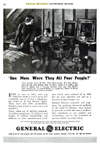
Were they "poor" -- or "organic"?
Click to Enlarge
Above is a look at a time when everything was pretty much "natural," "local," and "organic" -- except that it is from the perspective of the 1930s. You'll note that at that time, bathtubs, telephones and reliable electricity were not the enemies. Here is a picture of a more-or-less typical kitchen that transformed those local and organic foods into dinner. This 1917 photo, shows that the lady of the house has acquired a gas burner as a supplement to her earth-friendly wood stove. She is making some "artisanal" muffins in a functional kitchen. You couldn't get a 21st century woman anywhere near such a place -- for one thing, there are no granite countertops. It doesn't matter, since the contemporary yuppette couldn't boil water if her life depended on it, relying largely on exploited illegal aliens for "help."

"Artisanal" Kitchen Circa 1917
Click to Enlarge
With high, holy sincerity I hear from my young acquaintances about the desirability of eating "whole grains" and "free range chickens" and "local produce" -- even though the McMansions have consumed all the farmland within 100 miles of any major city. During the Depression, most folks desperately wanted to give up their fried mush for a Good Steak -- take a look at some of these ads from the 1930s. The problem then was that people had so little to eat that they were "skinny" and needed to gain weight. The Hair Restorer ad shows that some things never change. The "Frogs" ad shows the desperation of people trying to make a living no matter how unusual.



Social Dilemmas in the Mid 1930s
Click to Enlarge
As World War II cured the Depression, industry grew up to meet the demand for beef. As soon as the masses were eating steak, the positional goods crowd decried "red meat is Bad!" In response, whole industries grew up to provide poultry and farmed fish. When the unwashed masses were chowing down on salmon and chicken, the yuppie crowd invented a kind of food that cannot be mass-produced: local organic food. Of course, this type of fare is a lot more expensive than the stuff in normal stores. Thus was born the "Whole Foods Chain" -- a mass market for very high priced positional food goods.
I visited such a store when it opened in my neighborhood. I was struck by the fact that "positional" was marked by flowery justification for high prices:
- The store has a net carbon footprint of zero -- assessing a charge on each item to buy "carbon credits" to make up for the vast amount of energy used in their freezers
- The store only buys "fair traded" items -- assuring that third world farmers get a reasonable price for their goods
- The store offers "artisanal" items like pasta and cheese, meaning made in small batches
- The store has signs up about how well they treat farm animals, even though they sell butchered parts of these same animals.
So, our yuppie class can be very self-satisfied that they are doing good while shelling out to get their share of what is best (or at least what is most expensive.) These folks do not notice that the store is staffed a a diverse staff ("associates"), some of which may be of questionable immigration status. The "artisan" making your pasta could have been rolling tortillas in a mud hut two weeks ago. However, it is easy for the typical Yuppie to overlook immigration violations, especially since the unionized Safeway down the street does not offer positional goods.
Who audits these "carbon credits"? Are they worthless "offsets" sold by Krygistan?
"... According to industry analyst Ecosystem Marketplace, voluntary markets present the opportunity for citizen consumer action, as well as an alternative source of carbon finance and an incubator for carbon market innovation. In their survey of voluntary markets, data has shown that 'Corporate Social Responsibility' and 'Public Relations/Branding' are clearly in first place among motivations for voluntary offset purchases, with evidence indicating that companies seek to offset emissions 'for goodwill, both of the general public and their investors'...."
Who makes sure that the coffee really did come from "fair trade"?
"... The Adam Smith Institute claimed in 2008 that Fair trade has had little effect on the decreasing percentage of final sale value ending up with the producers as only a fraction of fair trade premiums reach producers. This claim is based on a calculation that only 10% of the fair trade premium for a cup of coffee at a popular London chain goes to purchase fair trade coffee beans instead of standard beans. This situation has led Tom Clougherty of the Adam Smith Institute, to describe Fair Trade as little more than a marketing ploy. ..."
It does not take much of a cynic to think that when a store's profit margin drops, the manager just might "forget" to buy his "carbon credits" or buy coffee on the wholesale market. After all the thing that he is selling is the image not the reality.
Back in the 1930s, things were different. People had just about all the local free range vermin-infested food they could stomach and were thrilled to see big gleaming supermarkets with glorious displays of perfect vegetables. Of course at that time, supermarkets were generally for the wealthy -- most mom and pop outfits dis not let the customer shop for his own stuff. They picked it off the shelf and the butcher put his thumb on the scale. Yes, service was personal -- and if you weren't the right kind of person, you didn't get much service. On the other hand, Mom and Pop felt the Depression as well and extended credit to their customers. Go into a Whole Foods Store and tell them that you'll pay them in two weeks -- see how humanistic and caring they are.
It was quite different in the mid-1930s -- synthetics were actually positional goods! Rayon was preferable to cotton and plastic to metal. Here are three articles from Popular Mechanics in the mid-1930s that will give you perspective on synthetics -- maybe you'll find that in the 21st century, there is nothing really wrong with plastics -- except that to yuppies they are accessible to the great mass of "ordinary people." If you shop at Whole Foods, you will be aghast at the "Food From Wood" article. If you didn't want to eat wood (,i>an excellent source of fiber) you could always make Rayon out of it.




Back When Synthetics Were Positional Goods
Click Here to download Part 1 of "Things Are Not What They Seem"
Click Here to download Part 2 of "Things Are Not What They Seem"
Click Here to download "Food From Wood"
Even back then, they were arguing that Rayon was "sustainable"
Click to Enlarge the Photos
As we search for sustainable transportation in the 21st Century, I'd like to recall the "Gazogene" cars used by the French during their occupation (1940-1945). If you look closely at French films of the late 1940s (such as Cocteau's Orphee), you'll see cars driving around with something that looks like a water heater strapped to the top or side, sort of like this:

A Gazogene Car -- Functional but Not Pretty
Basically, Motor Gasoline (petrol) was in short supply and reserved for the Occupiers (i.e. the Germans). The French met their transport needs using "biofuels." There were two types:
- Methane Digester (fueled by human and animal manure)
- Low Oxygen Combustion of Coal, wood, charcoal, etc
Each process had a different gas generator, but relied on several tubes to purify the resultant gasses (e.g iron filings to remove sulfur compounds). A second radiator was needed to cool the gas before carburation. This is schematic of the low oxygen combustion technology.
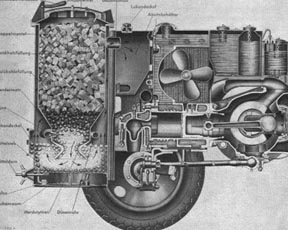

It Helps If You Can Read French...
Click Either Photo to Enlarge It
If you can't read French: The burner is a two part system: a closed chamber with chunks of wood in it, and a charcoal burner to heat the closed chamber and make the wood generate gases by a process called pyrolysis. Flammable gases produced by pyrolysis are then routed to a carburetor of sorts, mixed with air, and burned in the engine’s combustion chambers. Once the wood in the closed chamber has produced gases and turned to charcoal, it is transferred to the charcoal burner to heat the next load of wood.
Here are some articles from the 1938 that show that the French "anticipated" a shortage of gasoline. Possibly, they had their white flags printed at the same time.

1938 Articles about Gazogene
Click to Enlarge
Here is a picture of the quintessential French car of the period, the Citroen Traction Avant. The inverted "V"s n the radiator evoke an image of a cat, and these cars are affectionately known as the "CAT." This was an expensive car for the time and largely the province of municipal officials. Inspector Maigret may be seen hunting down criminals in a CAT. Here are two versions: a CAT that has been customized using sheet metal to hide the gas generation and purification equipment. Also shown is a CAT (Model 11A, c.1934-1937) with a methane digestion system on the top, decked out in Free French markings.
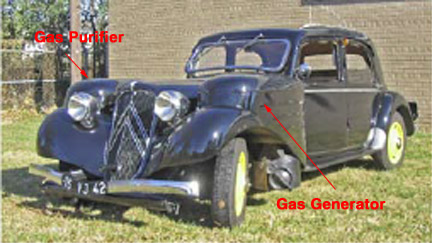

Running the Traction Avant on Alternative Fuel
The remarkable thing about gazogene technology was that it spread across France and was adopted in most of the occupied countries as well as Germany itself as gasoline became increasingly scarce. The technology became commercial and companies printed advertisements, as shown below:
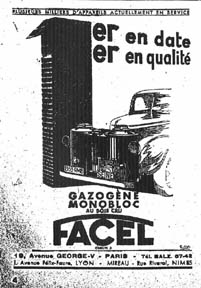
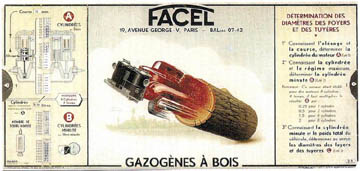
This was mainstream stuff!
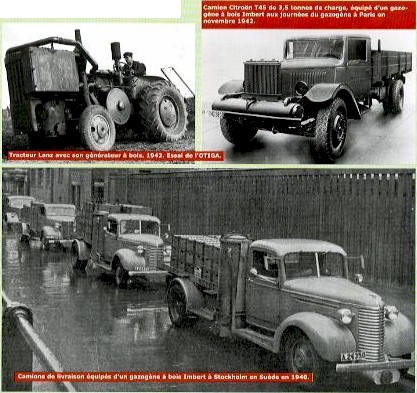
Whole Fleets of Gazogene Vehicles Emerged
Click Any Photo to Enlarge It
Even the rich got into the act -- here is a picture of a Citroen Traction Avant 7A Town Car (like a limousine) that has been converted to gazogene.

Just the thing for a Night at the Opera
If you still don't believe this, here is a video of a restored gazogene truck in action.
By the end of the Occupation, a whole fleet of taxicabs had been equipped with gazogene technology. A service industry grew up to collect and transport the fuel components from rural to urban areas; "service" stations evolved in which employees would "fuel" your car (you didn't have to shovel poo) and make sure that the components were working. Fear not, when we run out of oil, a solution will emerge. If you are thinking of mass adaptation of gazogene, you should read this report from the French Commissioner of Forests.
Have I forgotten Ethanol?
Ethanol is a fancy word for "moonshine" -- alcohol made by fermenting sugars. Since the dawn of the republic, farmers have been VERY interested in using distillation as a method for transforming their perishable crops into something with more shelf life. In general, governments have found that alcohol is a great way of raising revenue and Eastern Money Men have always found it in their interests to keep the farmers poor. In fact, early Americans in Western Pennsylvania tried to put "Government by Consent of the Goverened" to the test by refusing to pay an onerous tax on distilled spirits. The tax was even more insidious because small farmers had to pay by the gallon while large producers (like George Washington, a slave holder) paid a flat fee. This attempt to "actualize" the Declaration of Independence is now known as The Whiskey Rebellion. George Washington (the slave-holding large distiller) sent troops to crush the rebellion. After slaughtering a substantial number of farmers, the supremacy of the Feds was established. It also proved that the Eastern Money Men (typified by Alexander Hamilton) could be counted on to defend their interests regardless of the Noble Ideals of the Revolutionary War. Mind you, the Pennsylvania farmers were not evil bearded foreign anarchists -- they were the Good Solid White Protestant stock that is the bedrock of today's social stability myths. The Lawyers who wrote the Whiskey Tax were experts in using the complexities of the legislative process to Screw the Little Guy, much as they do today.
As the history of the US unveiled, ethanol continued to play a large role in urban-rural struggles, culminating in the Volsetad Act, more popularly known as "Prohibition." This legislation (actually an amendment to the Constitution) tried to solve the problem by making all alcohol illegal. As anyone who has seen Television knows, this had the unintended effect of creating a massive Organized Crime infrastructure. However, the gap between corn produced and corn actually sold -- most always a surplus that depressed prices -- was fertile ground for agitation between farmers (who wanted to make a living) and the Eastern consumers (who wanted cheap food.) Ethanol was again a very popular method for turning that surplus into a durable commodity. In fact, Henry Ford initially wanted to power all automobiles with ethanol because conventional wisdom held that there wasn't enough petroleum to meet the needs of an auto industry.
Here's an article from the December 1933 issue of Modern Mechanix that illustrates the social and economic dimensions of ethanol over and above its physical propertises as a fuel:
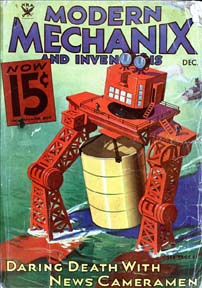
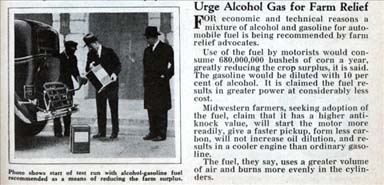
Fuel and Surplus Reduction!
From the December 1933 Issue of Modern Mechanix
Click on Either Photo to Enlarge it
If you think that blended motor fuel is something new (current gasoline in most areas contains 10% Ethanol), take a look at this article from the October 1937 issue of Popular Mechanics. Not only was blending available, but was offered in 200 plus locations! The article contains a mis-statement that is practically criminal. First, octane is a measure of a fuel's ability to be compressed without detonation ("knocking") -- BUT octane is NOT a measure of energy content. Thus, while the 15% ethanol blend did have "superior antiknock properties" it had about 3-5% less energy content than comparable high octane gasoline. That means less fuel efficiency and more trips to the gas station. This misleading fact has been repeated down through the decades, occurring as late as 2008 with a presentation by the [supposedly] well-informed McKinsey Associates to the Biomass Review Board.
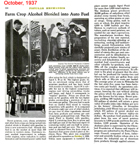

Blended Gasoline
(left): October, 1937 Issue of Popular Mechanics
(right) 2008 Presentation of McKinsey Associates to the Biomass review Board
Click on Either Photo to Enlarge it
The only flaws in the McKinsey analysis are:
- the blend ratio between a 112 octane fuel and a 60 octane fuel required to yield an 87 octane fuel would require the blend to be E51 [87 = a*112 + (1-a)*60), a=27/52 = 0.51]
- it is unclear what the costs of E51 blending would be or the utility of E51 in the motor vehicle fleet. This mixture would have 15% less heat value than E0
- this section is literally "true" (with regard to octane) but is probably not a plausible economic scenario, since large numbers of automobiles capable of using E51 would have to be on the road; the costs of re-equipping the nation's service stations and bulk fuel transport would be astoundingly high
“Ethanol Increases Fossil Gasoline Yield per barrel of Crude Oil” is totally misleading.
Ethanol continues to be a very potent issue in contemporary politics. The only thing new is that Global Warming (below) has enetered the picture. A very informative and entertaing website on Ethanol History is maintained by Bill Kovarik, a serious environmental historian. (Remember, most of the stuff here is to be taken with a grain of salt...)
So, we haven't forgotten Ethanol, or Biofuels from algae or any of the other zany ideas emanating from our government-fed science community.
I don't know about you, but some of the most dastardly enviro-scheisters are the rich lawyers and bankers that delight in "trekking" to the distant and far ends of the earth. They certainly punctuate their cocktail party conversation with tales of the sun over Katmandu or the verdant canopy of the Amazon Basin. The surface talk is romantic but the subtext is really, "I make so much money that I can afford to go anywhere I damn well please." And, they act to see that their exclusive wilderness is not despoiled by Average Guy Tourists. Once pacakge tours started to go to Costa Rica, these guys abandoned it for Tierra del Fuego. The idea is that the world should be kept clean for the exclusive use of the guy who just jacked up your electricity bill or who thought up a new credit card fee.
In the same league is the female prey of the globe-trotting yuppie -- the woman who threads her way to the office carrying a purse, a large satchel and a $6 coffee milkshake. (They can be identified in the dark by a "Hello Kitty" ringtone.) If they want that McMansion and Lexus, they had better play along with travel to the toilet holes of the universe. Many times, they can dream up credit card fees as well as the guys and have their own travel fantasies.
Together, the male and female of this species may be summarized thusly: "They would much rather spend a day with a headhunter than a steelworker."
The cause that attracts this crowd is the Rain Forest, once known as the Jungle. Nothing can be as sacred as preserving a hot, humid place filled with bugs, snakes and cannibals.


Logging Booms in Guiana!
From the November, 1953 Issue of Popular Mechanics
Click here to read the entire article
Click on Either Photo to Enlarge it
Things didn't use to be that way, as witnessed by this article from the November, 1953 issue of Popular Mechanics entitled "Logging Booms in the Guianas." Of course, back then, Lawyers and Bankers were under fairly strict social control.
Ever since the first shaman learned to set paper on fire with a piece of glass, solar power has been an alluring source of energy. It has remained so to this day, because it promises to be clean and plentiful. Plentiful in the sense that there are about 3 watts of solar energy per square foot of surface in the best of conditions. So, if you wanted to power a 60 watt bulb, you'd need about 20 square feet (10' x 2') of solar collectors -- if you could get all 3 Watts. Of course, you need that bulb at night....
Modern day shamans promise to use a complicated system of optics and batteries to harness the sun. Unfortunately, even the most marvelous photovoltaic devices don't come near getting all the available solar energy. Here is an October 2008 Press Release from the The Fraunhofer Institute, a big brain outfit in Germany:
"... researchers at the Fraunhofer Institute for Solar Energy Systems ISE in Freiburg have attained a 39.7% efficiency for a multijunction solar cell,exceeded their own efficiency record of 37.6%, which they achieved in July of this year. The result was reached using multijunction solar cells made out of III-V semiconductors. III-V semiconductor multijunction solar cells are used in concentrating photovoltaic (PV) technology for solar power stations. ..."
Thus, with a solar cell made out of transistors, they are able to capture about 1.2 watts per square foot. In order to replace all our dirty energy with clean, pure solar energy (during the day), you would have to cover the entire Southwest with things that are the equivalent of computer chips. Of course, you would have to spend a WHOLE LOT of money and energy to make these "multijunction solar cells." And -- what about the batteries that would be needed to store the energy so that you could use it at night? I seriously doubt that the Fraunhofer Researchers will be powering their new BMWs with solar cells.
Here in the US, we are also on a massive quest for the pure, clean energy from the Sun. One of the things that your Government is tossing lots of money at are Solar Concentrators, or big towers with lots of mirrors focused on a single spot. A small army of Porsche driving enviro-professors are busy at work on this project (unless the Surf at Santa Cruz is up). The thing looks like this:

Cutting Edge Research Funded by Your Tax Dollars
You may think that this technology is brand new. Well, that's not the case. Here is an ad from a 1941 issue of LIFE Magazine in which the same exact solar concentrator plays a key role.
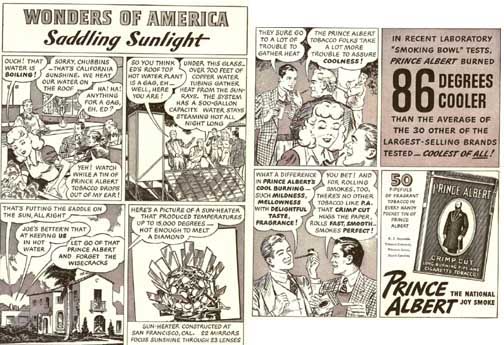
Maybe It Got A Grant Through Time Travel
From the April 7, 1941 Issue of LIFE Magazine
Click on the Photo for a Full-Page View of the Article
In turn, the ad is taken almost directly from the cover of the October, 1934 issue of Popular Science, so that most of the contents were pretty "old hat" by 1941. Adverising executives, like Enviro-Hucksters are not above borrowing from the past, especially if they think that it has been forgotten.
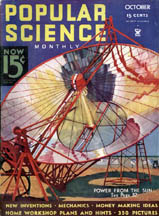

The DOE Solar Concentrator in 1934
From the October 1934 Issue of Popular Science
Click Here to Read the Whole Article
Going back to that cartoon, those 1941 enviros live in a home that has solar-heated water! This was apparently borrowed from the February, 1940 issue of Popular Science:
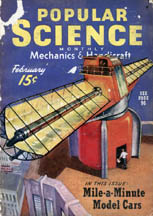
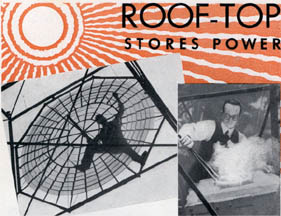
Home-Solar in 1940 -- They Didn't Need a Tax Credit!
From the February, 1940 Issue of Popular Science
Click Here to Read the Whole Article
Maybe the kids of these Solar Pioneers grew up to be Environmental Lawyers who live in a giant McMansion in a subdivision where ugly apurtenances like satellite dishes and solar collectors are banned..
Our review of Popular mechanics from 1932-1939 turned up a few more articles in the same vein -- heat your home at no cost, magical power from the sun. We are including them as well, just in case you haven't gotten the idea that most of this solar nonsense has been tried and failed. Even Photovoltaics was around in the 1930s.
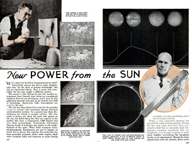


Solar Power in the Mid 1930s
(left) Popular Mechanics, October 1936
(middle) Popular Mechanics June 1935
(right) Photovoltaics - Popular Mechanics March, 1932
Click Here to read a compilation of articles about solar energy from the mid-1930s
Click Here to read a compilation of articles about Photovoltaics in 1932
We'll end this discussion of solar power on an ominous note: the government funds the aptly yclept Solar Trough Technology, ostensibly a place for our emerging enviro-aristocracy to feed.
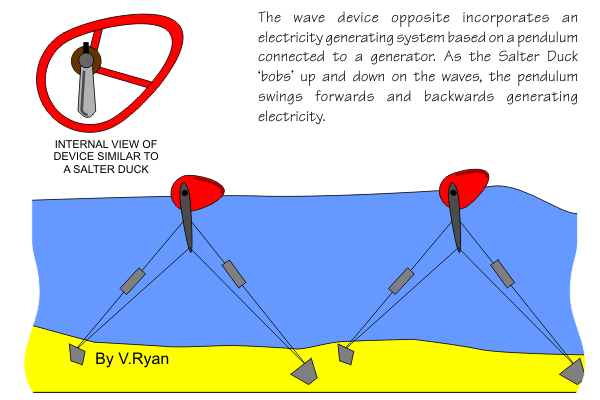
The "Salter Duck" Cutting Edge Technology
WOW! Our energy problems are solved! Our Government sure has hired some original thinkers!
Well, think again: Here's an article from the August 1932 issue of Modern Mechanix:
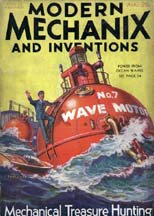

Unlimited Power From the Waves!
From the August 1932 Issue of Modern Mechanix
Click on Either Photo to Enlarge it
Here is an excerpt from the 1932 article -- or, you can read the whole article
...Upward of 40,000 inventions a year are granted patents by Uncle Sam, but not one of these offers a practical solution of the problem which scientists agree is the most pressing of them all: that is, how to harness natural sources of energy for power. ... WHAT is the most needed invention? Not television, not new kinds of airplanes, not speedier automobiles. Men of science are agreed that what the world needs most is a motor which converts the sun’s rays and other forms of natural energy into usable power. Orville Wright, Lee De Forest, Elihu Thomson, and other leading scientists are among those who proclaim the need for a new motor.... There are two sources of inexhaustible energy which at once occur to the inventor ,wave or tidal power, and solar rays. A. Los Angeles inventor has developed a wave motor, "an "inertia" motor, he calls it, which gives promise of being developed into a practical commercial project. ...Scores of so-called "wave motors" have been built in the past, but none has proved a conspicuous success commercially. Usually the initial erection cost and the maintenance cost has been out of proportion to the results obtained. And, too, the force of a storm has been underestimated, and the first severe gale completely wrecks the machine. ... The new "inertia motor" is absolutely storm-proof, in fact it could outride a tidal wave. And, too, it is the acme of simplicity,"it requires no foundation, and has no connection with the ocean bottom except by its anchor chains. ... When a wave starts to lift the hollow sphere, the massive weight inside, because of its inertia, resists the movement and exerts terrific pressure in the lower cylinder. Finally the inertia of the weight is overcome. Then it possesses momentum. When the sphere reaches the crest of a wave, the combined effort of the momentum and the recoil of the huge, semi-elliptic springs exerts an equal pressure in the upper cylinder. The tremendous pressure is applied to oil, which, in turn, operates a special turbine which runs a generator. The current is conducted to the shore by submarine cable. The idea seems wholly practical. It is readily conceivable that a battery of "inertia motors" could be built into an elongated float set parallel with the wave movement (see modern diagram above), and power in unlimited quantities would be available. ...The cost of building these motors would not be excessive, "the maintenance cost is almost nil, the storm hazard is eliminated. Collision is the greatest hazard, but this is hardly worth considering as the float would have "running lights" at night. A conservative estimate of the cost of the complete installation, except batteries, indicates that the value of the current generated, at 5c K.W. hour, would equal the installation cost in 18 months...
The article also contains 1932 artist conceptions of other [current] government supported R&D in: Temperature differential machines, and underwater turbines.
When the surf is down, the Library at UC Santa Cruz is filled with shaggy professors poring intently over old issues of Popular Mechanics or Mechanics Illustrated or Popular Science, looking for sound-bite ideas that will dazzle corrupt legislators and fatten the regulatory aristocracy.
The US Department of Energy (DOE) is developing a process for the anaerobic digestion of solid waste and sewage sludge into methane. Known as RefCOM - Refuse Conversion to Methane - the DOE experimental facility in Florida can process 100 tons of raw refuse per day with an output as high as 700,000 cubic feet of gas [Methane (CH4) + Carbon Dioxide (CO2)] per day. Based on an average home gas consumption of one million cubic feet per year, a 1,000 tons-per-day plant has the potential to meet the gas needs of over 7,000 homes. The objectives of the RefCOM experiment are to: establish information on the quality and quantity of gas produced; ascertain optimum operating parameters for both "mesophillic and thermophilic" modes (i.e. hot and cold bugs); and evaluate the reliability of the techniques. [source]
In other words, your government wants to get in the business of making gas from... well, your business. Possibly some of those envirozeitgeisterscheisters at Santa Cruz are giving you the business. In all fairness, this seems to make some sense -- that is, the stuff happens, so we might as well put it to good use. The fact that the plant probably costs more than the value of the gas produced over the next 30 years can be a problem, but who cares about money when we are saving the environment?
The problem comes when the would-be bureaucrats get hold of an idea. Here's a chart from a real, live Clean Energy and Carbon Finance Specialist showing an elaborate mechanism for trading money for waste. That is, quicker than a wink, he can turn your tax dollars into methane from poop after it has been filtered through a giant bureaucracy. Go ahead, vote green -- a million of these guys will spring up.
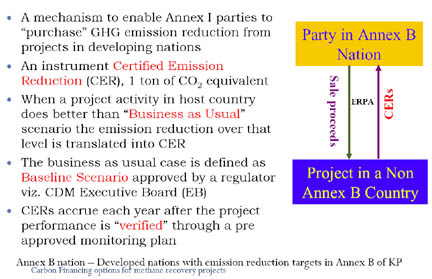
A Good Idea Gets Complicated Fast
Why are these things always International? Why can't the good people of Cleveland take care of their poop and let the people of Godumbaland take care of theirs? Of course, if the problem were local, these Carbon Finance Specialists wouldn't have lots of fancy world travel...
What's worse, this idea isn't even new! Here's an article from 1922!
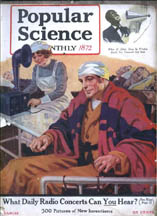
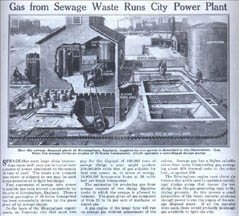
Anerobic Digestion of Sewage Sludge, 1922 version
From the March 1922 Issue of Popular Science
Click on Either Photo to Enlarge it
The only difference between now and then is that there were no 24 hour a day cable stations to tout this ... crap.
If poop isn't your ideal biomass, here's an article about how a professor was going to provide natural gas to the city of St. Paul by planting 3,000 acres of clover.
.
Natural Gas from Clover
From the November 1936 Issue of Popular Mechanics
Click to Enlarge
If all else failed, the Minnesota professor could feed the clover to horses and fall back on the 1922 poop method.
Acid rain is rain or any other form of precipitation that is unusually acidic. It has harmful effects on plants, aquatic animals, and infastructure. Acid rain is mostly caused by human emissions of sulfur and nitrogen compounds which react in the atmosphere to produce acids. In recent years, many governments have introduced laws to reduce these emissions.
This problem is not particularly new. Consider the following article that appeared in a 1941 issue of LIFE Magazine.


It Ate Stockings!
From the April 7, 1941 Issue of LIFE Magazine
Click on Either Photo for a Full-Page View of the Article
At the time, the railroads were steam-powered and most factories burned coal -- especially the electricity generation sector. The fuel was primarily sulfur-laden bituminous coal from West Virginia and Kentucky. It is amazing that the problem was so bad that Washington DC (with very little industry) was affected as much as the article indicates. This was a very serious problem and resisted any kind of solution until the 1960s.
Vast public debate on Acid Rain spawned the Clean Air Act which has been the mother lode for Environmental Lawyers. This law and its talmud/midrash are so complicated and confusing that nobody really knows what it is all about. It makes the outdoor burning of leaves a felony, and creates a Byzantine system of Pollution Credits and Allowances that may be traded as if they were physical commodities.
As of this writing, most of the same coal-burning powerplants from 1943 are still operating and burning the same fuel. The visible effects were cleaned up by 1980 or so. Most of the technology used to combat smoke was available in 1933! In addition, one scientist foresaw the Catalytic Converter by proposing that automobiles wear a "gas mask."
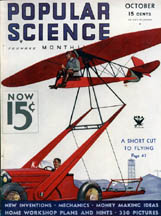
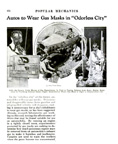

Catalytic Converters, Precipitators, Bag Houses, Most of Today's Technology
Auto Gas Mask: from the Septemnber 1932 issue of Popular Mechanics
"Deadly smoke": from the October 1933 Issue of Popular Science
Click Here to Read the Whole Article
Of all things, it has "worked" in a perverse sort of way - certainly ladies' stockings are not rotting away in real time, and "soot" is a thing of the past.
Global warming is the increase in the average measured temperature of the Earth's near-surface air and oceans since the mid-20th century, and its projected continuation.
Global surface temperature increased 0.74 ± 0.18 °C (1.33 ± 0.32 °F) during the 100 years ending in 2005. The Intergovernmental Panel on Climate Change (IPCC) concludes "most of the observed increase in globally averaged temperatures since the mid-twentieth century is very likely due to the observed increase in anthropogenic greenhouse gas concentrations" via an enhanced greenhouse effect. Natural phenomena such as solar variation combined with volcanoes probably had a small warming effect from pre-industrial times to 1950 and a small cooling effect from 1950 onward. These basic conclusions have been endorsed by at least 30 scientific societies and academies of science [all of whom get money from their governments] While individual scientists have voiced disagreement with these findings, the overwhelming majority of scientists working on climate change [on government grants] agree with the IPCC's main conclusions. The IPCC holds many meetings in the most scenic areas of the world. Scientists just LOVE to travel to these meetings [aboard carbon-emitting jetliners] with their nubile "assistants" and give long-winded papers before they retreat to the pool.
Although it is difficult to connect specific weather events to global warming, an increase in global temperatures may [note "may"] in turn cause broader changes, including glacial retreat, Arctic shrinkage, and worldwide sea level rise. Changes in the amount and pattern of precipitation may result in flooding and drought. There may also be changes in the frequency and intensity of extreme weather events. Other effects may include changes in agricultural yields, addition of new trade routes, reduced summer streamflows, species extinctions, and increases in the range of disease vectors.
This must be serious stuff, because there is a group of very earnest young people from Greenpeace standing at the door to my office. One young woman with big brown eyes seemed to be particularly choked up about "Evil Men in Suits who want to kill all the Polar Bears." The kids were hustling for signatures and money. The young lady will be a MMGCTMcM (Mom in a Minivan with a Granite Counter Top in a McMansion) before any Polar Bear (a nasty, vicious beast that eats charming little seals) is harmed. In the meantime, her money and petition will go to legislators who may be induced to pass a law requiring "Carbon Capture and Sequestration -- CCS" which is a mouthful for "Collecting carbon dioxide, compressing it and putting into a deep hole". This might be theoretically good, but no reliable technology for doing this exists, and "guesstimates" of the cost range from $15 to $50 per ton. The US emits about 6.5 billion tons of carbon dioxide every year, and CCS would cost from $90 bil to $300 bil -- just to put CO2 in a hole. My guess is that every Congressman, Mayor, Governor, or Alderman will soon have a brother-in-law in the Carbon-Sequestering business. For all your concern about the environment, you will get stuck with the bill in the form of Carbon Taxes. How much are you going to pay for reducing your Fear? How soon will it be before someone creates another Fear?
Of all things, Arctic Shrinkage was a "Good Thing" fifty-nine years ago. Here's an article from the January, 1949 edition of Mechanix Illustrated that argues for immediate melting of the Polar Ice Caps with Atomic Bombs (!) to prevent an ever-growing ice mass from tilting the Earth into another ice age. Someone took this serious enough to give it a mention on the cover of the magazine:

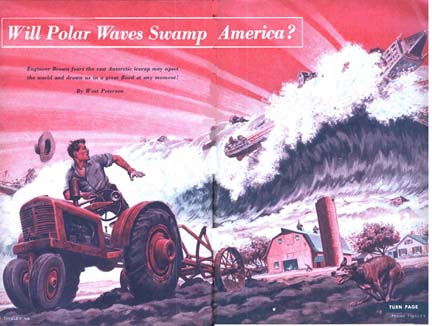
Watch out for that Ocean Liner, Pard!
From the January 1949 Issue of Popular Mechanics
Click on Either Photo to Enlarge It
Maybe you'd like to read the whole article before you make up your mind. However, we have a clear case of a "scientist" inducing "fear" to get "money" -- he wanted $10 billion!
On the other hand, here's something from the August 1953 issue of Popular Mechanics that only rated a small squib -- we even had to enlarge the article so you could read it:
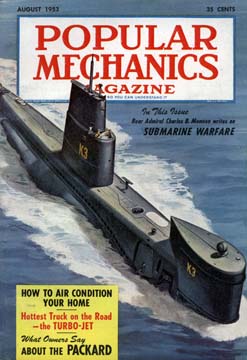
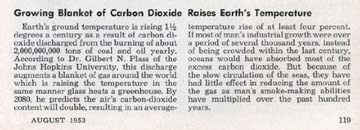
Beware the Greenhouse Effect!
From the August 1953 Issue of Mechanics Illustrated
Click on Either Photo to Enlarge It
The little-noted article agrees well with most contemporary predictions of the expected temperature rise, so one guy in 1953 seems to have done as well as zillions of "scientists" today. He even did it without a supercomputer weather model!!
Maybe Global Warming will cancel out the effects of Encroaching Polar Ice... Remember: Your Fear is someone else's Vocation.
In 1947, an idyllic time long ago (before trouble in the Middle East scared us down to the marrow), there was a Gas Price War in Los Angeles. There were some wonderful pictures of cars and fashion as LIFE Magazine went to Los Angeles. California was regarded by the rest of America as the land of the dollar-growing tree and the girl-edged swimming pool. It was (and is) the land of the automobile. In 1947, there ws one car for every three persons while in the rest of the country the ratio was 1:8. There were twice as many cars as bathtubs, more cars than refrigerators, stoves or even swimming pools. During the war, cars were scarce and gasoline was rationed. Howver, peace brought back cut-throat competition among Los Angeles' independent gasoline dealers. As post-war production brought back the buyers' market, Los Angeles dealers once more went after each others' trade, giving away cars, ranges, refrigerators, dishwashers, mixmasters,vacuum cleaners, clocks, roller skates, comic books, and bubble gum to get more customers. Business was up 30%.
Of note was an assemblage of prizes that a motorist could obtain by canny purchases of gas. Of all things, the very same Sunbeam Mixer, RCA radio, Detecto Scale and Presto pressure cooker as featured on our Collectibles Pages.
LIFE said, "In order to have obtained these items, you would have had to buy 5,000 gallons of gas, enough for [1947 cars to make] 14 round trips between New York and LA." This provides some interesting opportunities to compare Yesterday with Today. Mapquest says that Los Angeles and New York are 2782 miles apart, and 14 round trips would be 77,896 miles. If 5,000 gallons were required to do this, 1947 cars must have had a fuel efficiency of about 15.6 MPG. This sounds about right, because our '39 Buick gets about 15 MPG. Our 2008 PT Cruiser gets about 28 MPG, so it would require 0nly 2782 gallons of gas. Gasoline was about 10 cents/gallon in 1947 -- adjusted for inflation would be like $2.50/gallon today, less than the 2008 price of $3.65. At ten cents per gallon, it would have cost us about $500 to make the 14 round trips in a 1947 car. If we could magically transport the PT Cruiser back to 1947, we could have made the journey on for about $290.00 -- but we wouldn't have won the pressure cooker... However, on a real cost basis, gasoline prices are not that different between 2008 and 1947.
Of all things, the article about the Gas Price War was followed by a four page article on Gasoline from Coal.
"...Last week, the US got an exciting look at one blueprint of its industrial brave new world. Instead of mining coal to be burned in lumps, the Pittsburgh Consolidation Coal company proposes to make it into gas and liquid fuels; a pilot plant will be finished with the help of the Standard Oil Co of New Jersey and if it proves successful, Consolidation will build a full-scale plant near Pittsburgh to turn out 400 million cubic feet of gas or 14,000 barrels of high test gasoline a day...the synthesis of gasoline, diesel fuel and lubricating oils from coal will liberate the US from its life-and-death dependence on petroleum reserves..."
Note that energy independence was a concern, even in 1947.
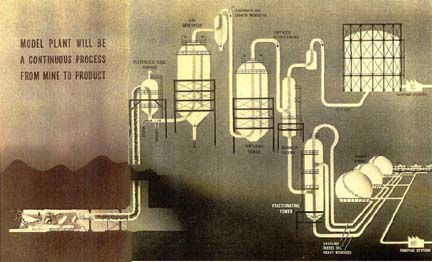
Gasoline From Coal, 1947
Click on the Photo to Enlarge It
Click Here to Read the FULL LIFE Magazine Article
The coal-to-gas process was not new, having been invented in Germany in 1910. During World War II, the Nazis used a variant on the process to produce enough synthetic gasoline to keep the army moving -- and to knock down a significant number of allied bombers trying to destroy the plants. In general, coal gasification systems have extremely high capital costs, even though they use an extremely cheap feedstock. Every time there is an "oil crisis", coal gasification gets trotted out and hawked to the public. During the shortages of the 1970s (remember the gas lines?), the Carter administration paid about $2 billion to build just such a plant in Beulah, North Dakota. It has changed hands several times at a fraction of its original cost but continues to operate -- of all things as the largest employer in North Dakota. (It is so much a relic of the 1970s that it is almost a monument to polyester leisure suits..) Right now, the Beulah plant manufactures anhydrous ammonia, (a far distant relative of gasoline by way of hydrogen) because there is a worldwide fertlizer crisis (save, of course, on Capitol Hill).
The Department of Energy continues to keep the ideals of coal gasification alive and there is a trade and lobbying organization called the Gasification Technologies Council that keeps it before Congress. The Energy Bill of 2003 contained subsidies for about nine "pilot" gasification projects.

Gasoline From Coal, 2008
Click on the Photo to Enlarge It
Source: US Department of Energy
About the only thing that seems to have changed since 1947 is the propaganda -- in 1947, industry claimed that the US had enough coal to last 3,000 years; in 2008, the Department of Energy claims that we have enough coal to last 250 years. One might conclude that we have used 2,750 years worth of coal in 57 years.
This issue adds yet another touch to our parade of irony in hydrocarbons: the Shell Oil Company had a full page ad about the deadly battle with the Leaf Hopper at Speonk. Let us listen in to the dialogue from more than 57 years ago...
"Yes, the leaf hopper is the bug. The Hedge Hopper -- the airplane -- is out to get him abd a billion others like him... in Long Island's vast potato belt, Leaf Hoppers were doing fatal damage carrying the virus of Hopper Burn from plant to plant..."
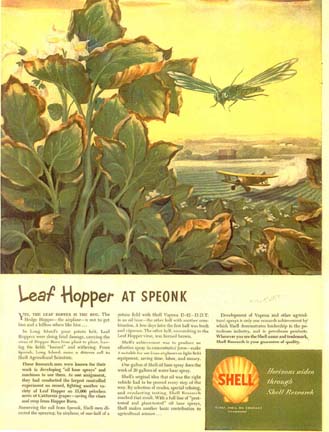
Leaf Hoppers in Speonk
Click on the Photo to Enlarge It
Needless to say, those progressive chemists at Shell Oil came up with an oil based spray that didn't get washed away like water-based sprays. The Potato Crop was saved! Science to the rescue! Well, not quite. The oil based spray had the trade name Vapona but it really was "dichlorodiphenyltrichloroethane", that eco-friendly substance known as D.D.T. Yes, the stuff that kills birds and cause cancer.
The vast potato fields of Speonk which once stretched as far as the eye can see (which according to the curvature of the earth is about 15 miles...) are no more, having been laid waste by a scourge much greater than Vapona.
The scourge was suburbanization. The potato fields (and all their DDT pollution) are underneath Levittown. In case you're interested, here is a photo that shows all the building materials, fixtures and appliances that were part of an individual Levitt-built house. In the background, you can see the potato fields being eaten up by the bulldozers.
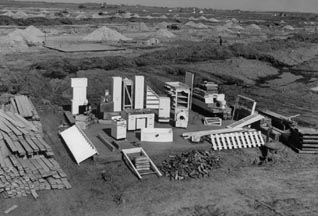
The Essence of a House in Levittown, c. 1946
Click Photo to Enlarge It
Last in our hydrocarbon follies is Hexane. This time, the scientists at Shell Oil focused on Olive Oil:
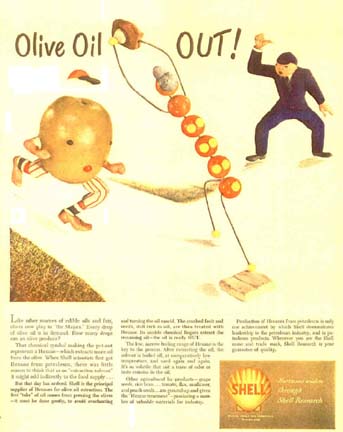
The Olive Can't Beat Hexane
Click Photo to Enlarge It

Note that the First Baseman is a Hexane Molecule
In the 21st Century, Rachael Ray, the omnipresent Food Network star coined the word "EVOO" for "Extra Vergine Olive Oil", or oil from cold pressing of the olives, that contains no more than 0.8% acidity, and is judged to have a superior taste. Extra-virgin and virgin olive oil may not contain refined oil. "Refined Olive Oil" (the cheap stuff at $4/Gal) is mase with the hexane process. Thus, Rachael and other Foodies are no pals of Hexane. Here's what the ad might look like if it were to be run in 2008:

None of that Refined Stuff!
There really isn't a whole lot of difference between 1947 and 2008 as far as Hydrocarbons are concerned.
Humans have been using wind power for at least 5,500 years, initially for natural ventilation in buildings and somewhat later to provide mechanical power. Relying on the ever-popular wikipedia, we find that:
"...The Babylonian emperor Hammurabi planned to use wind power for his ambitious irrigation project in the 17th century BC. An early historical reference to a rudimentary windmill was used to power an organ in the 1st century AD. The first practical windmills were later built in Sistan, Afghanistan, from the 7th century. These were vertical-axle windmills, which had long vertical driveshafts with rectangle shaped blades. Made of six to twelve sails covered in reed matting or cloth material, these windmills were used to grind corn and draw up water, and were used in the gristmilling and sugarcane industries. Horizontal-axle windmills were later used extensively in Northwestern Europe to grind flour beginning in the 1180s, and many Dutch windmills still exist. In the United States, the development of the 'water-pumping windmill' was the major factor in allowing the farming and ranching of vast areas of North America, which were otherwise devoid of readily accessible water. They contributed to the expansion of rail transport systems throughout the world, by pumping water from wells to supply the needs of the steam locomotives of those early times. The multi-bladed wind turbine atop a lattice tower made of wood or steel was, for many years, a fixture of the landscape throughout rural America..."
Our interest here, however, is the use of wind in generating electricity. The same wikipedia article seems to think that this aspect began in 1980.
Au contraire, it looks like the Dirty Commies perfected wind generation in the 1930s!

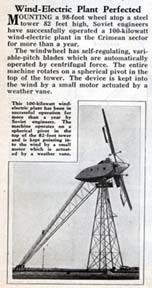
Perfected Wind Power at the Height of Stalinist Excess!
From the November 1934 Issue of Modern Mechanix
Click on Either Photo to Enlarge it
Maybe this is why the leftist enviorcrats in the government are so hot on wind power!
On a smaller scale, wind energy was powering radios on farms from the 1920s up until the 1950s. Farmers were familiar with wind power, many using it to pump water. In addition gasoline for a combustion generator was expensive and required a periodic trip to town.

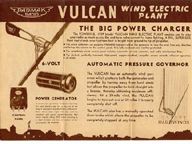

The Market for Wind Turbines was Competitive in the 1920s and 1930s

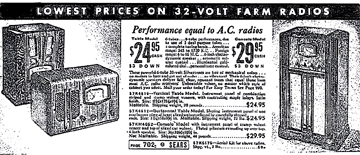
The Wind Turbine Was Used to Provide DC Current for the Radio
All of the Big Mail Order Houses sold "Farm Radios"
Click to Enlarge
If there wasn't a whole lot of wind, you had another option: a gasoline or kerosine powered generator. To give you an idea of how complicated this was, here is a picture of one of my readers cooking a steak on a Farber Broiler Robot This is actually a fairly advanced generator that was also used to power lights and farm machinery. You can buy things like it at most home centers. Then and now, you still have to buy the gasoline and cart it back home. The enviro-hippies paint a picture of a lovely decentralized world where everyone generates his own electricty and doesn't have to buy from the evil Guys in Suits. Suppose all your neighbors had their own gas-powered generator -- the noise would drive you crazy and the exhaust would choke you.


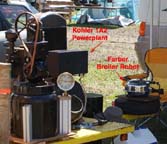
Combustion Alternatives to Wind Power
(left) The Sears Power System
(middle) Coal-Oil (Kerosene) Battery Charger
(right) The Kohler 1A2 Power System
Click to Enlarge
The primary motivation for installing any kind of generator was simply to listen to the radio. In the 1920s, radio sets were pretty inefficient ant required a lot of current to keep those big tubes working. The only problem is that the wind is intermittent -- you can't count on it blowing just when Amos'n'Andy is on. Farmers had solved the intermittency problem for water by erecting storage tanks. When the wind blew, it pumped water up into a tank standing on metal legs about 15 feet high. When the water flowed out, it had enough pressure to provide a reasonable facsimile of modern plumbing. [The two key concepts are Storage and Pressure] The intermittency problem for wind generation was solved with the electrical equivalent of the tank -- the storage battery. If you just want to listen to the radio, you could use a small battery. But -- if you wanted to run lights, machinery, and appliances, you needed a whole slew of batteries, as shown below:
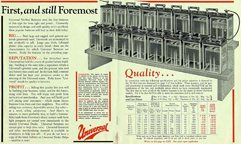
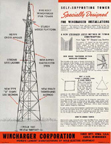
"Accessories" for Do-It-Yourself Wind Power
The Universal Battery System
The Wincharger Tower System
Click to Enlarge
You had to erect a fairly substantial tower and climb up there to tinker with the mechanism. If you ever harbored thoughts that the farmers of the 1920s were lazy rubes, forget it. The tower (and generator) came in a box, and the farmer had to erect it, keep it running -- including climbing back up the tower after a major storm to fix whatever damage had been done..
..What kind of damage, you say? The Dunn system illustrates one of the major problems with wind generation -- something that still plagues even the most modern versions. If the wind has too much force (e.g a violent thunderstorm) the blades of the propellor or the bearings will be damaged. Every wind generator has some kind of governor change the angle of the blade so that they stop when the wind speed goes above a certain point. The Wincharger used sliding weights, and the Dunn system uses springs. Modern wind turbines have computer controls to "feather" (change the angle) of the turbine blades. All are really vulnerable to Tornadoes and Hurricanes
Below is an article from 1932 that proposed putting wind turbines on skyscrapers. If you look at the article, it seems to be a harebrained idea. On the other hand, Mayor Bloomberg offered a proposal to do just that to pacify the rich enviro-hippies of the big Apple. Not to be outdone, the Kingdom of Bahrain (noted for making energy conscious decisions like building indoor ski-runs in the desert) actually put a wind turbine on one of their gaudy skyscrapers. Mayor Bloomberg's proposal was laughed off the stage. As of February 2011, the "regular people" of Bahrain got sick and tired of all this nonsense and tried to toss out their "enviro-conscious" royalty.


Windmills on Skyscrapers
(left)A harebrained 1932 idea to put Windmills on top of skyscrapers
(right) Actualization of harebrained idea in 2007
Click to Enlarge the Photos
Here are three articles from Popular Mechanics in the mid 1930s that illustrate concepts about wind power. We are even offering a handsome ".pdf" containing the full text at no cost to you.


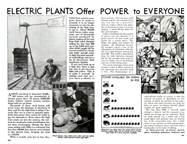
Electric Plants Offer Electricity For Everyone
(middle) The Wincharger ad anticipates the Rural Electrification Administration
Click here to download a "pdf" with the full text of the articles
Click to Enlarge the Photos
Was this a hobby of a few "trendy" farmers of the 1920s? Not at all -- there were a fair number of competitors in the market and all major manufacturers produced household and farming appliances that could be run on the DC current generated by the windmill. You'll note that both Wincharger and Vulcan went into partnership with radio companies. For a while, if you bought a Zenith console radio, you got the Wincharger (less tower...) for free.

The Convertible Radio
Use it now and when Hi-Line Power comes...
Note: "when" not "if"
Click to Enlarge
So, why has America's mass involvement with wind-powered distributed generation totally absent from the history books? The answer is simple, once the Rural Electrification Administration (REA) came to the farm with reliable AC current from the power company, the farmers GLADLY stopped climbing the tower and fiddling with the acid in the batteries. They switched on the lights, read their paper and let a milking machine take care of the cows without ever having to worry that the current would flicker out -- or that their expensive generator would get blown off the tower. In truth, the very popular REA saved farmers from Distributed Generation.
Fluorescent lamps that screw into standard incandescent fixtures are now widely available. Where aesthetic considerations allow it, this is a very simple way of increasing efficiency and extending lamp life. Estimates of the national impact of widespread use of these little gems vary, but your wide-eyed activist says that if we just switched to these, we could close down all the evil powerplants being run by equally evil old men in suits.
There are pros and cons about compact fluorescent light:
- The Good: Compact fluorescent lamps typically use 75 percent less energy than incandescent lamps for the same light output. They also have over 10 times the lamp life of an incandescent lamp.
- The Bad: Compact fluoresecent bulbs cost about 10 times more than incandescent bulbs; depending on size,they take a period of time to reach full intensity -- from a noticable 50 ms for a 60 watt equivalent up to 1 minute delay for a 150 watt floodlamp; they have a slight flicker that has been implicated in causing seizures in some epileptics; cheaper versions of these bulbs cast a greenish light making most folks look like ghouls
- The Ugly: The envirocrats have forestalled your choice by making the manufacture of incandescent bulbs illegal after 2015.
The same hippies that want you to use an outhouse are now telling you what kind of lightbulbs to use. The founding fathers would be aghast at this invasion of your home. The vast bulk of these crappy gadgets are made in China, so the enviro-elite is exporting jobs while they restrict your choices. You can be damn sure that the Kennedys aren't going to use these in their palaces, since your slick enviro-lawyer can find a way around anything for the rich and bring down the wrath of the cops on the poor working stiff.
What's more, these things aren't even new! Both mercury vapor lamps and a screw-in fluorescent fixtures were available back in the 1930s!


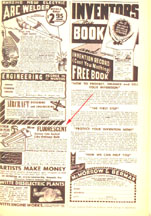
Energy Efficient Lighting
(left) Article on mercury vapor lamps from the May, 1934 issue of Popular Mechanics
(middle)Cover of the April 1942 issue of Popular Science
(right) Ad for screw-in fluorescents from the April, 1942 issue of Popular Science
Click to Enlarge
Screw-in Fluorescents (made in China) may be the wave of the future, but rather than outlawing incandescents (made in the USA), the government should stay out of it and allow the manufacturers of the new technology to win the economic and technology performance competition fair and square. The American people do not need to have their thinking done for them! In early 2011 several legislators introduced a bill in Congress to do just that. I will update this page as further developments occur.
For those of you who are not "up" on the latest envirospeak, "LEED" is an acronym that stands for Leadership in Energy and Environmental Design and is based on the Green Building Rating System developed by the U.S. Green Building Council. Just in case, you think that we are making this up, here is the full dope on LEED Certification from the aforementioned Green Building Council. As you pore through this mass of future-speak, you'll note that "green" means neither "edited for redundancy" nor "plain English":
"...LEED certification is a recognition that a construction project or building can attain by utilizing environmentally friendly building practices during construction or remodeling. The model was developed in 1998 to encourage environmental awareness amongst government agencies, architects, engineers, developers, and builders...."
"...LEED certification can be attained on four different levels, which are determined by a credit, or point, system. The levels of LEED certification are Certified, Silver, Gold, and Platinum. A building or project can attain LEED certification by submitting an application that documents compliance with the requirements set for in the LEED rating system. The Green Building Council issues LEED certification upon satisfactory application, review and compliance verification. There are fees associated with LEED certification...."
"...While design and construction of buildings have used environmentally friendly practices in the past, LEED was developed to provide a streamlined set of building standards. The government has worked to model sustainable green building by achieving certification on many of its state buildings. In order to increase the number of new and redeveloped buildings eligible for LEED certification , the government also offers many incentives within the building industry, including grant funding and tax breaks based on the level of LEED certification attained...."
"... LEED professional accreditation is also attainable by individuals, contractors, project managers, and other industry professionals. Professional accreditation demonstrates that an individual or company is well-versed in the LEED system and can work with other individuals and developers to oversee the building process and follow guidelines to attain LEED certification...."
"...Some of the practices utilized or observed for LEED certification include the use of recycled material, eliminating or reducing the amount of waste leaving a job site, re-using existing material, using sustainable green building material, and using low-emitting materials such as caulk and sealers. LEED certification can be achieved in both new construction, as well as renovations.... [Source]
The Green Building Council sums up the benefits of LEED Certification as follows:
- Valuable and marketable credential for employers, prospective employers, or clients
- Listing on USGBC website directory of LEED Accredited Professionals
- LEED AP certificate Recognition for involvement in LEED project
- Eligibility for projects on which owners are mandating the participation of a LEED Accredited Professionals
- Strengthened qualifications when responding to RFPs (Government Request for Proposals) requiring LEED Accredited Professionals
- Encourages employees to continue increasing their knowledge and understanding of green building and LEED
Let's try to simplify this a little bit:
- A group of people with a particular point of view have created a so-called system for declaring buildings to be "environmentally friendly"
- This group has the implicit backing of Federal muscle (i.e tax credits and those RFPs)
- This group offers training so that individuals can get in on the bandwagon as "inspectors" (you can even get certified online. There is a whole industry in this training, including coaching and test preparation)
Thus, the same people who dreamed up the idea are the gatekeepers to the secret insider knowledge. If you learn the secret LEED handshake (after forking over your dough) then you can feed at the Federal enviro-trough. As I see it, there is very little difference between LEED and Scientology, but that's another whole web page.
Recently, I received an invitation to a meeting to discuss new changes in the LEED cabal. Here's a fairly censored version of the invite:
"... Please join us for a program dedicated to LEED 2009. Learn how the credit weighting has changed; how regionalization has been addressed; the adjustment of baseline references and point distribution; LEED AP changes and more! You won't want to miss this one! Our guest speakers will be xxx and yyy of zzz Co.. XXX is a Sustainability Manager and is on the board of the
What do you want to bet that XXX and YYY drive a Mercedes and live in a McMansion at least as big as their pompous titles? -- and do so while they pick your pocket with astounding green-guru gobbledygook! Do you think that XXX or YYY has ever had a hammer in their hand? Could they change a flat tire? There is a goatherd in Bungastan who is thinking that weak Americans who make nothing but rules are easy prey. There is a Communist bureaucrat in China who is laughing his head off at this nonsense!
Of all things, as of August 30, 2009, many are starting to recognize exactly what a charade LEED is. An article in the Earth-Friendly New York Times said:
"... Builders covet LEED certification — it stands for Leadership in Energy and Environmental Design — as a way to gain tax credits, attract tenants, charge premium rents and project an image of environmental responsibility. But the gap between design and construction, which LEED certifies, and how some buildings actually perform led the program last week to announce that it would begin collecting information about energy use from all the buildings it certifies. Buildings would provide the information voluntarily, said officials with the United States Green Building Council, the nonprofit organization that administers the LEED program, and the data would be kept confidential. But starting this year, the program also is requiring all newly constructed buildings to provide energy and water bills for the first five years of operation as a condition for certification. The label could be rescinded if the data is not produced, the officials said.
The council’s own research suggests that a quarter of the new buildings that have been certified do not save as much energy as their designs predicted and that most do not track energy consumption once in use. And the program has been under attack from architects, engineers and energy experts who argue that because building performance is not tracked, the certification may be falling short in reducing emissions tied to global warming.
Some experts have contended that the seal should be withheld until a building proves itself energy efficient, which is the cornerstone of what makes a building green, and that energy-use data from every rated building should be made public.
'The plaque should be installed with removable screws,' said Henry Gifford, an energy consultant in New York City. 'Once the plaque is glued on, there’s no incentive to do better.'
Scot Horst, the council’s senior vice president for its certification program, said that any changes in the process would have to be made by consensus to ensure that the building industry would comply. Already, some construction lawyers have said that owners might face additional risk of lawsuits if buildings are found to underperform. ..."
The New York Times, "Some Buildings Not Living Up to Green Label" By MIREYA NAVARRO Published: August 30, 2009
So, intuitively and deductively, this is a money-making power grab. There are going to be some sweet young ladies with big blue eyes are going to say," You are SOO Negative. Don't you think that they are doing Good (.. while doing good...)?" Well, I'll let the sweet young things make up their own mind. Here is the ONLY (repeat only) building that comes close to the LEED standards for perfection. With a score of 61 points out of 69, I give you... [drum roll]
"... a carbon-neutral, net zero energy building (ZEB). Because of the efficient building techniques used, the Legacy Center requires very little energy Specifically, the Legacy Center qualifies as a:...
"...Site ZEB: Building produces at least as much energy as it uses in a year, when accounted for at the site. The Aldo Leopold Legacy Center produces all of its needed electricity through on-site photovoltaic arrays. It does burn wood in the winter for heat, but this resource is harvested locally and is a renewable resource used on-site...
"...(1) Source ZEB: Building produces at least as much energy as it uses in a year, when accounted for at the source. The Legacy Center is considered a source ZEB because the energy generated on-site through PV and wood is greater than the energy used when accounted for at the source. (2) Emissions (carbon) ZEB: Building produces at least as much emissions-free renewable energy as it uses from emission-producing energy sources annually. The excess renewable energy the Legacy Center produces, along with on-site carbon sequestration through its forested land, offsets the carbon emissions resulting from the project's operations....
"...The Foundation located the project on a previously disturbed site, which it is restoring to native ecosystems. The project team used crushed gravel in place of blacktop or concrete paving, increasing rainwater infiltration and blending the developed areas into the surrounding landscape. The native landscaping requires no irrigation. Waterless toilets efficient faucets reduce water consumption by 65%. An on-site well provides potable water. Thinning the Leopold forests improved forest health while providing 90,000 board feet of wood for use in the project. More than 75% of all wood used in the project was certified to Forest Stewardship Council standards, and 60% of all materials were manufactured within 500 miles of the project site....
"...The Legacy Center was designed to use 70% less energy than a comparable conventional building. A 39.6-kW rooftop photovoltaic array produces more than 110% of the project's annual electricity needs. This excess renewable energy, along with on-site carbon sequestration, offsets the greenhouse gas emissions resulting from the project's operations. Daylighting eliminates the need for electric lighting during most of the day. Ground-source heat pumps connected to a radiant slab provide heating and cooling, and an earth-tube system provides tempered fresh air...."
What does all this really mean?
First, this has an inside joke: Zeb is also the name of a local person who operates a micro-biorefinery just down the road a piece. Second, let's look at the official photographs:

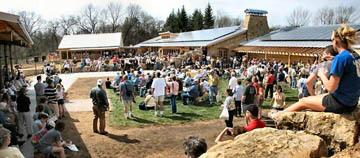
Official Photos of the Leopold Legacy Center
Note VERY CAREFULLY that the pictures were taken in the Summer
Zeb delivered about 30 quarts for the celebration
Click on Either Photo to Enlarge it
This looks like a very nice place, sort of like a ski-lodge. It's in the woods and the photo shows a lot of enviro hippies celebrating. (They always have something to celebrate, because they really don't have to work very hard, other than to collect their checks and browbeat people who have a real job...) In general, it looks like a nice country place. In fact, that previously disturbed site was the lodge of a rich guy named Aldo Leopold, a life-long fisherman and hunter, something like Sarah Palin. Leopold died in 1948 from a heart attack while fighting a brush fire on a neighbor's farm.
DEDICATED HUNTERS AND FISHERS


(l.) Aldo Leopold Hugging a Tree (r.) Sarah Palin Armed to the Teeth
Mr. Leopold was a Professor who wrote influential books about the Environment and Ethics
Ms. Palin has the Hottest Butt in Politics
Leopold's heirs dumped the estate on the State of Wisconsin in return for a big tax deduction and probably bought BMWs with the money they saved, as rich heirs are wont to do. (I really don't know what happened to the boodle from evading the estate taxes... however, I am certain that ouraged envirocrats or LEED Certified Professionals will write to me about the noble deeds that were performed... Come to think of it, Baraboo is not that far from the People's Republic of Madison, and some of that 1948 loot may have gone to the Alger Hiss Defense Fund)
Let's look at the photos that I took (February, 2008) of the only LEED PLatinum Certified Building.
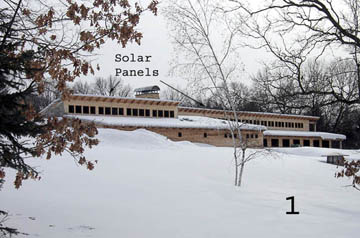
The Leopold Center in Winter
The Solar Panels are Snowed In

The Leopold Center Driveway
Who Shoveled the Snow?
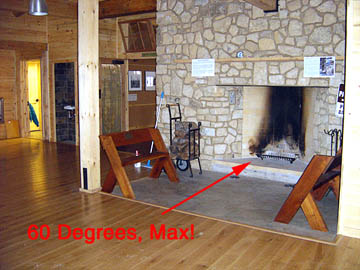
The Backup Heating System
A Balmy 60 Degrees...
Click Any Photo to Enlarge It
First, you'll note that there are no hippies gyrating to the beat of a dulcimer. Next, you'll see that the vaunted solar photovoltaic array is covered with snow -- the little greenies are going to have to buy some of that bad old reliable electricity from the Evil Men in Suits at the local Utility. No Zero-Emissions on the day I took the photos. The Outside temperature was below zero. The often hyped zero-emission geothermal heating system wasn't able to keep the building warm, so they had to emit a little carbon through the fireplace, keeping the Center at a balmy 60 degrees. Did real-live enviro-hippies really cut, split and stack the wood? I'll bet they didn't! You'll also note that the parking lot (Prius only?) is completely clean. Did the envirocrats shovel the snow? More likely, they called some minimum wage blue-collar guy and had him bring his bad old diesel front-loader over. I wonder if the diesel emissions went into the net energy balance at the Leopold Center that day?
Now about those toilets... For some reason, the Rich and Powerful have a thing against flush toilets. For years, one of the Rockefeller Heirs has been bankrolling the Clivus Multrum", a "waterless composting toilet." The Rockefeller family is worth Zillions -- if they want to use a glorified outhouse, that's their business. Why should this thing be touted as the epitome of "Green Buildings?" Make no bones about it -- the rich and elite are so comfortable that they can worry about the consequences of their toilets while the blue collar guy who runs that snowplow probably lives in a trailer and would be thrilled to have a big bathroom with a jacuzzi and a bidet. Instead of doing something for the legions of working class people that they exploited and maimed, the Rockefellers want to launder their reputation with concern about the Environment. From their lofty perch, they think that it would be just dandy if you had to use a detached composting toilet.
Speaking of Toilets, in May of 2011, none other than Bill Gates got into the toilet business. An article in TIME Magazine (July 3, 2011) was headlined "A Human-Waste Gold Mine: Bill Gates Looks to Reinvent the Toilet" Presumably, everyone will have to upgrade their toilet every three years, they will crash frequently and be subject to viruses. Possibly, they will pass "marketing information" back to Seattle...
Gates is new money, not the dissipated loony eighth generation of the original robber barons. Bill reaped his fortune the old fashioned way -- by creating and enforcing a monopoly. By all rights, he should be off in a giant mansion, presumably stocked with servants, racehorses (and in his case, an infinite supply of Cheez Curls). Well, it turns out that Bill is out to save the world -- that is, the so-called poor in underdeveloped countries. Like all in the wealthy elite, the poor in America are to be exploited and mocked. It is only the denizens of Godumbaland that are the intended benefts of his generosity -- possibly, they will say "Gee Massa Bill, you is a saint, not a computer nerd."
We were going to write about the geeks down in IT that set their own flatulence afire, but we had better get back to the Leopold Center
Briefly then, the Leopold Center is a cabin in the woods with an outhouse. Those words are much too simple for the elitists who use "Harvest" to mean "cut down trees". (By the way, why is it OK for Granolas to "harvest" trees in Wisconsin and it is EVIL for Lumberjacks to do the same thing in Oregon? I think that the difference only exists because the latter are blue collar workingmen that aren't easily gulled by a bunch of Professors and Bureaucrats. ) So, behold the Leopold Legacy Center -- a foretaste of what the Commissars have in store for you. Vote Green now -- but don't have any second thoughts when you're sitting in a cold dark outhouse fumbling for the Code of Federal Regulations...
The general tone of American Society in the Swing Era was that (a) Things couldn't be much worse than the Great Depression; and (b) Science is going to provide a wonderful future for everyone. Here are some examples of "Faith in the Future". One theme that runs through these articles is Radio, the "Gee Whiz" technology of the decade. There is a curious fascination that somehow radio would be used to transmit significant quantities of electrical power. Even Winston Churchill got into the act -- his forecast was a mixture of nuclear power and genetics to provide food, light and energy for the masses. In a curious sentence he says that [through technology advances]:
"... There is no doubt that the civilized races can produce all the food they need. Indeed, some of the problems that vex us today are due to the prodyction of wheat by white men having exceeded their needs before yellow men, brown men, and black men have learned to demand a diet superior to rice. ..."
You will remember that these words were written by a distinguished English leader and published in a respectable mass-market magazine. From my trip to the Whole Foods Market, it appears that the wealthy class of the 21st Century has re-discovered rice and the mysterious East.
So, for what they are worth, here are articles on "The Future" from 1932.

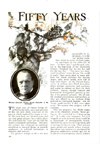

The Future as Foreseen in 1932 by Popular Mechanics
(left)Article on Progress from the April 1932 issue
(middle) Forecast for 1982 by Winston Churchill March 1932 issue
(right) House of the Future Article in September, 1932 issue
Click Any Photo to Enlarge It
We are pleased to present the entire text of these aricles for your critical review. You will note that NOBODY is very good at predicting the future. You shoulkd keep this in mind the next time you hear Prof. Blowhardski rant about what might happen to the climate 30 years from now.
- The Progress issue of Popular Science
- Click here to download Part 1
- Click here to download Part 2
- Click here to download Part 3
- Click here to download Part 4
- Click here to download Part 5
- Click here to download Winston Churchill's article
- Click here to download "The House of the Future"
We'll agree that things could not get much worse than the Depression, but Science has had only mixed success in providing for us. Looking at the Leaf Hopper and Hexane ads (above), science sometimes created things with unintended results. Nuclear energy and Space Exploration are two particular areas in which the promise of the 1930s has been muted.
Nuclear Energy
Subatomic particles were all the rage, even before the war. Here is another ad from the makers of Prince Albert Tobacco that takes an amiable young man (who looks like Clark Kent) on a tour of a cyclotron. The ad actually uses a few well-done images to more-or-less accurately convey the nature and purpose of the cyclotron. Most likely the pictures were taken from diagrams in Ernest Lawrenc's 1934 Patent 1,948,384 for the device. The ad appeared in 1941, so nothing is particularly new -- other than the fact that the cyclotron was considered interesting enough to sell tobacco. In the simplified drawings, I can't tell whether it would be more dangerous to stand around the unshielded cyclotron or smoke the tobacco.

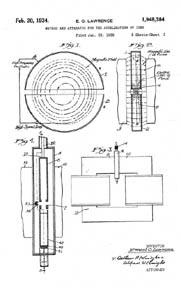
(Left) Price Albert Tours the Cyclotron
(Right) Ernest Lawrence's Patent No. 1,948,384 for the Cyclotron
No Security Breach -- All this is/was Public Information
Click here if you want to learn how to get Free Patent Drawings
After the war, people became quite well acquainted with the destructive power of nuclear energy. The following ad promises to send a child an "Atomic Bomb Ring" upon his consumption of a fairly large quantity of breakfast cereal. I'll bet that little Kim Jong Il was among the first to send in his box tops. As the child playfully (Jeepers!) sees "real atoms split to smithereens", his Mom is happily baking a cake with "Softasilk" cake flour. This particular ad captures the fascination with nuclear energy as it became a commonplace thing in society. No longer was smashing atoms done in big labs, but right in the home.

The Atomic Bomb Ring
Nuclear energy went on to be the bane of our existence as we explored policies like Mutually Assured Destruction and reckoned casualties in megadeaths. Alongside this, we built 103 nuclear reactors to generate electricity. The initial promise was that the juice would be "too cheap to meter." Although this has not taken place, it is worthwhile to note that the Energy Information Agency suggests that Nuclear power costs about 3.5 cents per kilowatt-hour. This is about 60% cheaper than it's next rival, coal combustion and about 99% cheaper than electricity from photovoltaics.
So, people are not lining up to tour cyclotrons and kids can't play with nuclear devices in the kitchen. However, nuclear energy supplies about 30% of all the electricity that we use -- and it emits no greenhouse gasses.
Space Travel
During the 1930s, there was considerable interest in rockets. Generally, scientists wanted to develop the capability to send a rocket to a very specific location. Generally, this intention was in the form of "Rocket Mail". In the compendium below, you'll find that the Germans were very interested in delivering the mail by rocket. They were not able to deliver mail to New York, but they eventually succeeded in delivering "packages" to London.

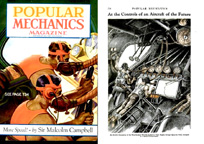
Rocket Mail
(left)Cover of summary article
(right) The control room of a future rocket ship
(It looks a whole lot like the cab of a locomotive...)
Click here to download the article on rocket mail
Click Any Photo to Enlarge It
The following ad more-or-less summarizes popular hopes about the future of space travel. The idea was that interplanetary travel would develop along the lines of the Airlines. Most people in 1941 had watched airplanes go from dangerous wood and cloth crates to sleek, shiny, streamlined luxury liners, all within a period of about 25 years. Thus, it was reasonable to expect that in another 25 years or so, space travel would have evolved. This was not all wrong, since the US landed a man on the moon in 1969. His "business trip" took about 15 years to schedule and cost several billion dollars, but at least half the appointment was kept.
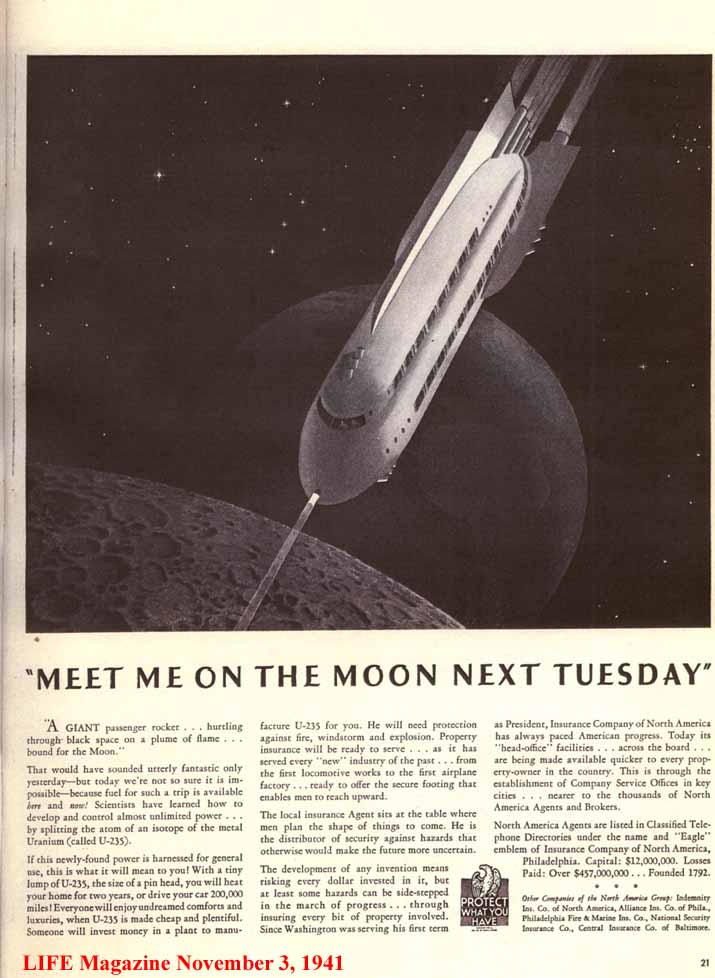
Meet Me on the Moon
The ship in the ad looks eerily like the Space Shuttle. We are still a long way from regularly scheduled passenger service to the Moon.
Highway Planning
Everyone hates traffic. Probably since time immemorial, mankind has dreamed up schemes to reduce congestion. This probably goes back to the Roman Empire when a bright young Tribune proposed HOV lanes for the Appian Way or one way streets in the Forum. The advent of the automobile at the turn of the century had spawned a traffic monster by the 1940s. Here is an article from LIFE Magazine in 1938 that shows the evolution of highway systems:

The Evolution of Highways
Click Photo to Enlarge It
The length of each line is the distance that could be covered in one hour starting from the center of New York City. At the bottom is an "expressway" that was far advanced in 1938. Today, it would be VERY outmoded. However, the article concludes that within one hour you could get 50 miles outside NYC in rush hour. Those of you who may have waited in downtown traffic to go six blocks in an hour will find this especially amusing. Alas, all those marvelous highways have done is increase the range of suburban sprawl, funneling even more cars into the central city. It is of some interest to note that the 2008 website for the Maryland Intercounty Connector (a hotly debated highway project near Washington DC) contains virtually the same claims as made in this 1938 article.
One scheme to avoid crowded highways was to create automobiles that could fly. From 1906 through 2006, inventors peppered the market with a variety of flying cars. None of them "took off".
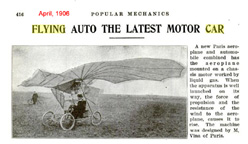
Flying Cars
Click Here to download a compendium of articlea sbout flying cars from 1906 to 2006
Click Photo to Enlarge It
The more things change, the more they stay the same
Home | About Lindy | 1940s Collectibles | Upcoming Events | Vintage Clothes
The Guide - Establishments - Travel - 1940s Artifacts
Music | Links | Photo Gallery | Extras | Contact